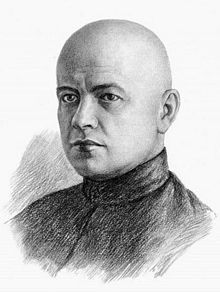Stanislav Kosior
| Stanislav Kosior Станіслав Вікентійович Косіор |
|
|---|---|
 |
|
| First Secretary of the Communist Party (Bolsheviks) of Ukraine | |
|
In office 14 July 1928 – 27 January 1938 |
|
| Preceded by | Lazar Kaganovich |
| Succeeded by | Nikita Khrushchev |
|
In office 25 March 1920 – 17 October 1920 |
|
| Preceded by | Nikolay Bestchetvertnoi |
| Succeeded by | Vyacheslav Molotov |
|
In office 30 May 1919 – 10 December 1919 |
|
| Preceded by | Georgiy Pyatakov |
| Succeeded by | Rafail Farbman |
| Candidate member of the 15th Politburo | |
|
In office 19 December 1927 – 13 July 1930 |
|
| Full member of the 14th, 15th Secretariat | |
|
In office 1 January 1926 – 12 July 1928 |
|
| Personal details | |
| Born |
Stanislav Vikentyevich Kosior 18 November 1889 Węgrów, Siedlce Governorate, Russian Empire |
| Died | 26 February 1939 (aged 49) Moscow, Soviet Union |
| Nationality | Polish |
| Alma mater | Sulin industrial elementary school |
| Signature |  |
Stanislav Vikentyevich Kosior, sometimes spelled Kossior (Russian: Станисла́в Вике́нтьевич Косио́р, Ukrainian: Станіслав Вікентійович Косіор, Polish: Stanisław Kosior) (18 November [O.S. 6 November] 1889 – 26 February 1939) was one of three Kosior brothers, Polish-born Soviet politicians. He was General Secretary of the Ukrainian Communist Party, deputy prime minister of the USSR and member of the Politburo of the Communist Party of the Soviet Union (CPSU). He is considered one of the principal architects of the Ukrainian famine of 1932 to 1933, known as the Holodomor in Ukraine. He was executed during the Great Purge.
Stanisław Kosior was born in 1889 in Węgrów in the Siedlce Governorate of the Russian Empire, in the Polish region of Podlaskie, to a Polish family of humble factory workers. Because of poverty, he emigrated to Yuzovka (modern Donetsk), where he worked at a steel mill. In 1907 he joined the Russian Social Democratic Labour Party and quickly became the head of the local branch of the party. He was arrested and sacked from his job in the party later that year, and the following year felt obliged to leave the area due to police activity. He used connections to get re-appointed at the Sulin factory in 1909, but was soon arrested again and deported to the Pavlovsk mine. In 1913 he was transferred to Moscow and then to Kiev and Kharkiv, where he organized local Communist cells. In 1915 he was arrested by the Okhrana (the Russian secret police) and exiled to Siberia.
...
Wikipedia
